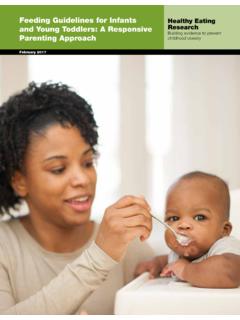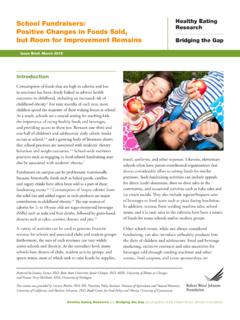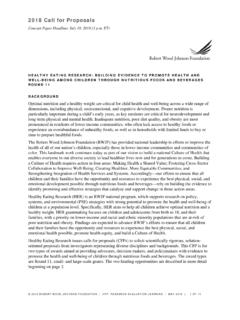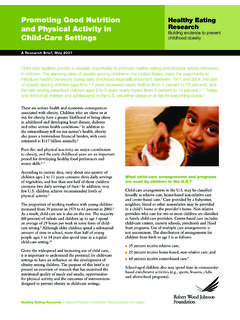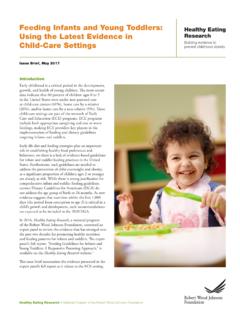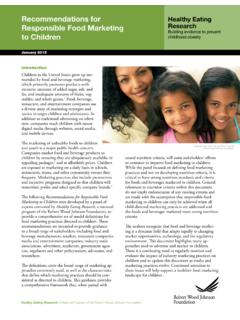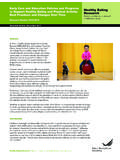Transcription of Minimum Stocking Levels and Healthy Eating …
1 IntroductionThe healthfulness of foods and beverages found in retail food stores differs widely across the United States, both by location of the store as well as by store type. Communities with predominantly white residents have two to four times more supermarkets and large-chain grocery stores than communities of ,2 In contrast, lower-income and communities of color have more small food outlets, such as small food stores ( corner stores ) and convenience ,3 These small food stores primarily tend to sell pre-packaged foods and beverages that are high in calories and poor in nutrients.
2 They are also less likely to sell Healthy , staple foods such as fruits and vegetables, whole grain-rich foods, and low-fat dairy Thus, some communities have limited access to stores that carry healthful foods, and these limitations likely contribute, at least in part, to disparities in diet and ,10 As such, several strategies are now being implemented in many locations across the United States to increase access to Healthy foods in underserved communities. One strategy is to attract grocery stores or supermarkets that currently are not located in these lower-income neighborhoods and communities of color.
3 However, opening a new store requires substantial investments, and it is not clear that this strategy is feasible and/or appropriate in all settings. A second strategy is to improve the healthfulness of foods and beverages sold by existing food retailers in underserved communities, including retailers that are both small and large in size. Evaluations of Healthy corner store programs have demonstrated success in increasing the availability, visibility, affordability, promotion, and sales of Healthy foods and beverages in small Whether the goal is to attract new stores to a neighborhood or change the ones that already exist, there is a need to identify the Minimum amounts of healthful foods and beverages that stores, particularly smaller food stores, should stock on their shelves.
4 There is also a need to recommend how these healthful foods and beverages should be marketed to consumers. Carrying healthful foods and beverages, but not effectively marketing them, is unlikely to have an impact on the purchase and consumption of these items. February 2016 Healthy Eating Research A National Program of the Robert Wood Johnson FoundationMinimum Stocking Levels and marketing strategies of healthful Foods for Small Retail Food StoresHealthy Eating ResearchBuilding evidence to prevent childhood obesity2 Minimum Stocking Levels and marketing strategies of healthful Foods for Small Retail Food Stores | February 2016 RationaleThis report is aimed at pointing out the need for both carrying healthful foods and beverages and marketing them.
5 It identifies basic, Minimum Stocking Levels for healthful foods and beverages in small retail food stores. For stores already meeting these basic Levels , it identifies preferred Levels of Stocking that provide access to a wider range and larger supply of healthful foods and beverages. The report also provides marketing strategies that stores should adopt to enhance sales of healthful foods and report is expected to help local, state, and federal efforts to improve the healthfulness of foods and beverages sold in a variety of small retail food stores.
6 It could be used in setting standards for financing of new retail food stores in underserved communities, designing Healthy retailer certification programs, and other local policies and initiatives. The recommendations in this report may also be used to inform policies for stores participating in ongoing federal programs, like the United States Department of Agriculture s (USDA) Supplemental Nutrition Assistance Program (SNAP). Many of these stores do not currently stock a variety of Healthy Expert Panel RecommendationsThe recommendations included in this report were developed by a panel of experts in food retail, nutrition, and obesity prevention.
7 The panel was convened in 2015 by Healthy Eating Research, a national program of the Robert Wood Johnson Foundation. To develop Minimum Stocking Levels , the panel reviewed and analyzed evidence from a wide range of sources, including: peer-reviewed, scientific research; recommendations and guidelines from the federal government, scientific bodies, national organizations, and public health organizations;14-28 and existing requirements for retailers participating in nutrition- and/or health-related policies and programs at the local, state, and national Recognizing that increasing customer demand is an important complement to increasing availability of Healthy foods, the panel also developed recommendations for evidence- and practice-based strategies to increase Healthy food and beverage sales through retailer marketing .
8 Particularly in-store marketing more information on the panel process and methods used to develop these recommendations, please see Appendix I. Definition of Small Retail Food StoresFor the purposes of this report, retail food stores are broadly defined as stores that have retail floor space dedicated to foods and/or beverages.* This definition includes stores that sell a range of merchandise, including foods and beverages as well as other products ( , dollar stores, retail pharmacies); however, those stores that primarily sell non-food merchandise but often have foods and beverages in checkout areas are not included ( , home goods stores, electronics stores, office supply stores).
9 Improving the healthfulness of foods and beverages promoted and sold in these types of stores should be addressed in future work. Regardless of type, all retail stores participating in federal nutrition assistance programs, such as SNAP or the Special Supplemental Nutrition Program for Women, Infants, and Children (WIC), are included in this definition. Stores not authorized to accept SNAP or WIC may also be included if they meet the definition above. Additionally, the definition of retail food stores here does not include farmers markets or mobile food vendors.
10 For the purposes of this report, small retail food stores are limited to those that meet the definition above and have no more than three cash registers that may be used for food and/or beverage and Preferred Stocking LevelsThe Stocking Levels established by the expert panel are structured around food categories and nutrition guidelines in the Dietary Guidelines for The categories include: fruits and vegetables, low- and non-fat dairy and fortified soy beverages, whole grain-rich staple foods, and meat/protein, plus an additional category for Healthy beverages.
